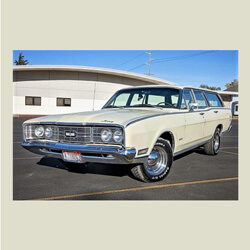Memoir:
In 1974, my aunt, uncle, and young cousin came to visit from Germany. At the time our only car was a 1972 Mercury Cougar with bucket seats in the front and a tiny back seat. So, my dad found a 1969 Mercury station wagon for $800, with bench seats in the front and back, and a huge cargo area. We went on a road trip to California, spending nights in one story cinderblock motels with kidney shaped swimming pools. As was the norm in those days, the dads sat in the front and the moms in the back seat, while we kids made our cozy nests among the luggage and blankets in the “way back”. Being sixteen, I got first dibs on the best section right next to the rear window so I could stretch my bare legs along the full width of the car. I got the best tan that year.
On the way home, we swerved inland stopping in Reno to pick up gallon bottles of Jim Beam and Gilbey’s. Four of each were stashed in a hidden compartment underneath the floor of the cargo area. That space was probably meant to hold the spare tire and jack. We covered the hatch with an unzipped sleeping bag. There was a checkpoint at the California-Oregon border to audit whether people were transporting fruits and vegetables. But I worried that we would be caught transporting tax-free booze.
After my relatives left, the station wagon was the car I learned to drive in. My dad perched on the passenger side of the bench seat, his hand gripping the dashboard while I navigated that long white boat of a car over country roads. When I finally got my license after turning seventeen, I drove to school on days when I had theater practice or speech tournaments. Sometimes I drove to the mall. I wasn’t one of those adventurous kids that filled the car with friends to drive to a swimming hole or keggers, but that station wagon signified freedom for me. I kept a cardboard box with candy bars, water, and a blanket, just in case. The smell—some weird off-gassing of the burgundy plastic seats, redolent of BO—reminded me of the trip to San Francisco, the bootlegging, the meditative rootlessness of a long road trip. The car was so big and solid, I felt protected, even though it conked out at every stop sign for the first few miles on my way to school. Even though the gas pedal fell off, so that I simply pressed my bare foot against the iron rod that poked out of the floor to make it go.
After graduation, I moved to the city to attend Portland State University. There was no point in having a car. My dad gave it to the same uncle and aunt who by then had immigrated to the US. The uncle, who had a job as a mechanic at a BMW dealership, broke an axle when he “accidentally” drove it into a wheat field. Not everyone loved that station wagon the way I did.
For the next decade plus, I didn’t own a car, didn’t drive at all. After PSU, I moved to Seattle for grad school, and rode the bus everywhere. Later I rode the bus downtown to my marketing jobs at various banks and relied on my then husband for trips to the grocery store. It wasn’t until we moved out to a rural area that I got my driver’s license. We bought a used 1983 Toyota Tercel station wagon, and I white-knuckled my way through the driver’s test, while the woman with the clipboard next to me coached me through it. Max and I spent hours commuting in the “mommy car”, hitting the drive thru for an Egg McMuffin every morning before I dropped him off at daycare.
Nearly every car I’ve owned was some form of station wagon—or at least a hatchback. Cars with trunks don’t make sense to me. What if you were trapped in it? How would you get to your emergency supplies if they’re in the trunk? The PT Cruiser was the roomiest: we fit a 6-foot Christmas tree into it, the fragrant crown poking between the front seats. The 1999 VW Beetle was the worst. It had a hatch, but I couldn’t go to Costco without folding down the back seat. Every car had an emergency kit based on my stage in life. Diapers in the Tercel; granola bars and art supplies in the Wrangler. Mickey shakes his head at how much stuff I have in my Subaru, all the flares and first aid kits, extra shoes and a raincoat, two blankets, and a corkscrew. You never know. I might have to go on a boot-legging trip.
Vera Wildauer lives in Manzanita with her husband, Mickey, (who owns five vintage cars, none of which are station wagons), and two cats. She is “still” working on her novel, but strays from that fraught relationship by writing short fiction and poetry. Thank goodness for Community Writes.


